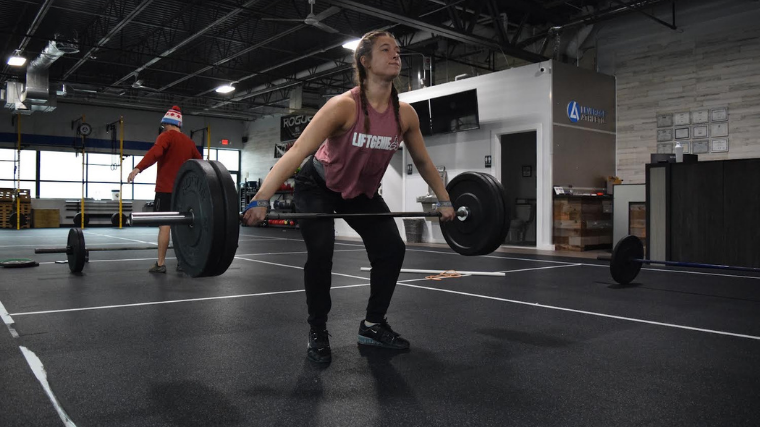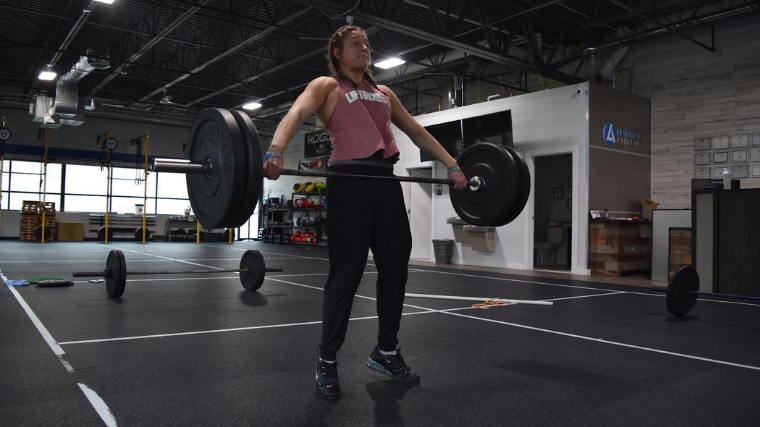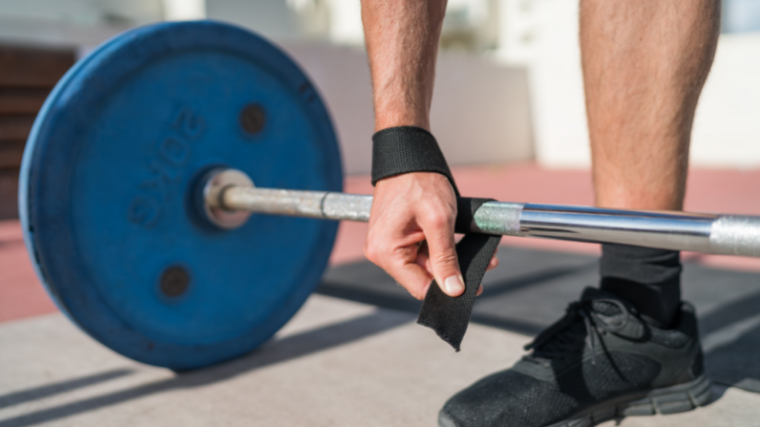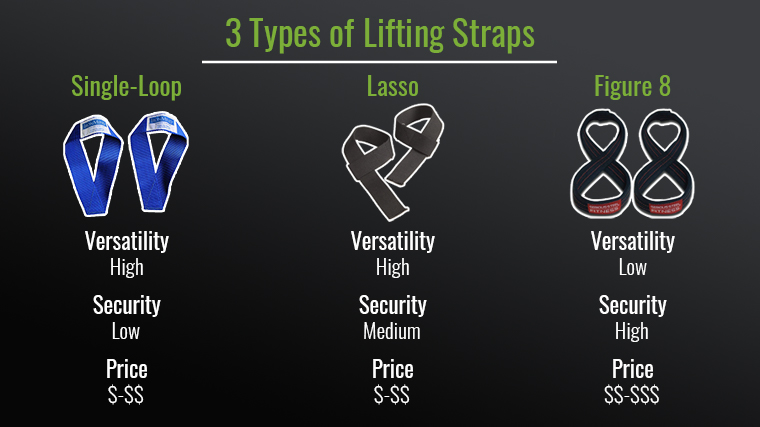When practicing weightlifting, things can get a bit heavy-handed. Moving a barbell necessitates tons of pulling, which means having a respectable level of grip strength. Your hands have a lot of responsibility in the sport. If you want to lift a new personal record, you have to hold onto it.
To lift well, you have to stay connected to a roughly-surfaced barbell. Wear and tear to the surface of your hands can eventually become a limiting factor in your performance. Even when you have stellar grip strength, discomfort in your hands can still hold you back when there’s work to be done.

As such, Olympic lifters commonly rely on weightlifting straps throughout training. Straps secure the barbell to your hands so that you don’t have to use as much effort to hold onto the weight. When they’re used the right way, they help you get stronger. This is everything you need to know about using them to your advantage.
- What Are Weightlifting Straps?
- Types of Weightlifting Straps
- Benefits of Using Weightlifting Straps
- How to Use Weightlifting Straps
- When to Use Weightlifting Straps
- Best Exercises to Do With Weightlifting Straps
What Are Weightlifting Straps?
Weightlifting straps are supportive cloth materials (nylon, canvas, or leather) that wrap around your wrists and the barbell. They fasten you to the weight by wrapping around the bar under your hands. They’re a common accessory in a weightlifter’s bag for movements such as pulling or snatching.
The straps work by providing thorough support to your grip. You still have to hold on to the bar with straps, but a ton of the pressure is removed off your hands when they’re used. They make holding onto the bar more manageable and are specifically designed for the safe practice of the lifts.
Types of Weightlifting Straps
It may come as a surprise given their simplicity, but not all straps are created equal. In fact, you can use a multitude of different designs depending on your specific training needs. Here are a few of the most commonly-seen types of weightlifting strap and what sets them apart from one another.
Closed-Loop
Closed or single-loop straps are the gold standard for most weightlifters. They’re sewn or bound together at one end, with space for your hand on the other. Single-loop straps strike a nice balance between grip security and ease of escape — you can effortlessly release your grip from the barbell if you have to exit a lift gone wrong.
Lasso
Lasso straps are more beginner-friendly and are sometimes made of more heavy-duty materials. The lasso strap provides space for your wrist as well as a long strip of cloth for you to wrap around the bar as many times as you’d like.
This provides an unbreakably-secure grip on the barbell, but may not be the most comfortable for your wrists in the overhead position. They also don’t release as freely as some other variants.
Figure-8
Made primarily for deadlifts, heavy pulls, and even strongman training, figure-8 straps go the extra mile to bind your hand to the bar. You’ll find it nigh-impossible to lose your grip, but this comes with a tradeoff.
Figure-8 straps take a bit of effort to apply and unwind, so you probably don’t want to rely on them when you work the classic lifts (or their variations), as your hand is glued to the bar the whole way through.
Free
One of the older, more improvisational styles of strap, the “free” strap is merely a strip of cloth that isn’t sewn or bound together at any point. They take some dexterity to use properly, but some weightlifters find them to be the most comfortable and versatile option of them all. Free straps don’t “glue” your hands to the barbell, and allow you to effortlessly release your hands at any point.
Benefits of Using Weightlifting Straps
Training with straps lets you use more effort in the gym without being limited by a faltering grip. Here are a few more specifics that back the tactical use of straps in your training.
A Reinforced Grip
When you use straps, you’re fully connected to the bar. They provide total enforcement of your grip and, in a way, hold the bar “for” you until you choose to let go. This solidifies your grip to a much further extent than normal, which often feels more comfortable during the lifts and allows you to work with an increased training volume.
Hand Protection
Without straps, a textured bar wears against your palms, which can cause skin irritation and tearing over time. Taking the pressure off your hands with straps helps keep them healthy and happy. With the cloth texture between your hand and the bar, straps make it feel almost as if you’re not even touching the barbell.
More Reps
Lifting with straps makes your bond to the barbell even closer. By saving your hands, you’ll likely be able to complete more reps of the lifts incorporated into your weekly plan.

If your hands become too worn out to continue a workout, straps might be just what you need to finish your work. For example, if you use straps for your pulls on Monday, you can spare your hands and save them for any heavy lifts on Tuesday or Wednesday.
Higher Confidence
When you use straps, you become one with the barbell. Even though the weight feels just as heavy, the extra layer of protection makes it feel a little easier to stay with the lift. This often increases confidence when going for the lift, especially as the bar gets heavier.
How to Use Weightlifting Straps
The loop part of the strap should lay flat and tight to the back of your wrist. Grab the end of the straps between your fingers and thumb. As you place your hand on the barbell, loop the strap underneath and around the bar and back towards you. Pull the loop tightly between your fingers, and place your hand firmly over the top of the strap, onto the barbell.
Grip the barbell as you normally would with the strap wrapped under your hand. When fastened, your hand should feel tight to the barbell. When working with straps, you don’t need to use a hook grip.
When to Use Weightlifting Straps
Using straps the right way means using them at the right times. There is, after all, such a thing as being too reliant on them, such that straps become something of a performance crutch. You need to make sure you’re working with them at the right times.
On Pulls
One of the best uses of straps is when you’re working your lifts from the floor via pulls. No matter what kind of pulls you’re doing, straps are always handy.
Any pulling exercise such as deadlifts, snatch grip deadlifts, snatch or clean pulls, or hang pulls are commonly done with straps. You should do a combination of pulls both with and without straps to maintain adequate grip strength. You can work with bare hands while warming up, and then break out the straps for the heaviest sets to come.
During High-Volume Days
Straps benefit your high-volume training by allowing you to do more reps without your grip limiting your performance. Your grip will remain intact without fatiguing your hands and forearms, so you can string more reps together.

[Read More: Our Favorite Forearm Workouts, + the Best Forearm Exercises]
They also help you complete more sets in general by protecting your hands from the wear and tear of resistance training, especially during heavy pulls.
On Technique Work
Straps are useful for the technical training of your lifts, such as when you’re practicing them early on. If you don’t have to think about holding onto the bar, you can pay extra attention to your movement and positions.
Beginner weightlifters often find the hook grip to be distractingly uncomfortable — technique-focused exercises with straps help you zone in on just that.
When You’re Out of Competition
Straps are not allowed in most sanctioned powerlifting or weightlifting competitions. Sadly, the extra grip advantage would be too powerful. They’re fair game in training, and using them outside of competition can boost your strength and confidence for the meet, even though you can’t wear them on meet day.
If you have a meet coming up shortly, avoid overusing your straps and developing a reliance on them. To make sure your grip strength is intact while still using straps, add a grip exercise to your accessory at the end of your workout.
Best Exercises to Do With Straps
There are lots you can do with your straps. Now that you know when and how to use them, you’re ready to incorporate them into your plan. Here are the best exercises to use them on.
Deadlift
The deadlift is one of the heaviest lifts out of all, and straps support them wonderfully. When you pull to the hip, the position of your hands on the bar doesn’t change, meaning that the straps stay in perfect place once they’re put on.
Using straps for deadlifts is the best way to train them without an intense grip requirement. You might just be able to pull more weight with them on. They’re extra beneficial when you don’t have chalk, or are lifting on a low-quality barbell.
Snatch
Straps are ideal for snatch work of all variations. They feel comfortable in the pull and are hardly noticeable in the catch position overhead. You can wear them in full snatches, or use them when completing reps from the hang. They help tremendously for stringing complexes and reps together.
If your straps are quick-release, you can still miss a snatch in front or behind you because your straps will release when your hands eject the bar. You should practice many reps in the snatch with straps before you progress to heavier loads. You’ll need to adjust to the feeling of releasing your hands from the barbell.
Note: Straps are not designed for doing cleans. This is due to the challenging mobility requirements of the front rack catch position in the lift.
Snatch or Clean Pull
A successful lift always starts with a good pull. When training the Olympic lifts, doing just the pull component is a strategy to build strength with the correct technique.
Extra pull work should be done regularly in your program, and this is made easy when you use straps for your pulls.
Row
Rows of all kinds can be done with straps. Whether you’re doing barbell or dumbbell rows, straps take a lot of the expectation off your grip when it comes to this movement.
When rowing with straps, you can fully focus on lat engagement, and likely squeeze out a few extra reps per set.
Strap In
Taking care of your hands is taking care of your body. Straps complement holding onto the barbell in so many ways, especially when you want to push the limits of what you can do in the gym. If your goal is to build strength, the extra reps that result from using straps will go a long way in the long run.
Lifting with straps is so convenient that, at times, it can seem like cheating. This is only the case, however, if strapped work takes center-stage during your workouts. Strapping up is a safe and effective way to do your heaviest lifts, without costing you your grip strength. Use them properly and you’ll see why world-record-holding weightlifters and casual hobbyists alike lean on them for gains.
Featured Image: Riley Stefan
